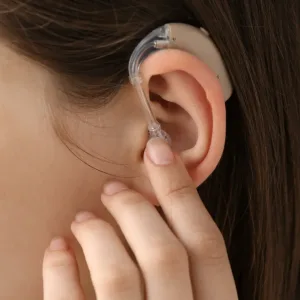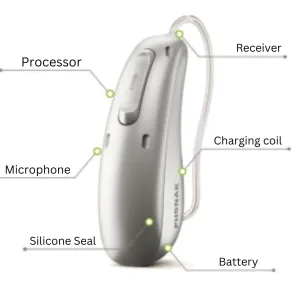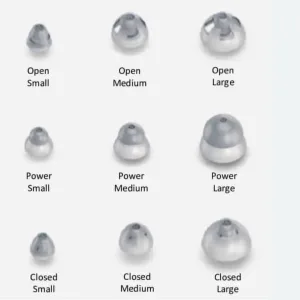Hearing aids play a pivotal role in enhancing hearing and speech understanding for those with hearing loss. A hearing aid works by amplifying sound vibrations. Let’s explore the parts of a hearing aid and how they function to bridge the gap in hearing loss.
Understanding the Essential Parts of a Hearing Aid
At the most basic level, every hearing aid consists of a microphone, amplifier, and speaker. Digital hearing devices include one extra piece. So what does each part actually do?
- Sound Reception: This is where it all begins. Sound waves hit the microphone, initiating the process.
- Amplification: Next, the microphone converts these waves into electrical signals. The amplifier then boosts these signals.
- Digital Processing: In digital aids, a processor refines these signals. It adjusts them to match your hearing loss and the settings programmed by your hearing care provider.
- Sound Delivery: Finally, the receiver (or speaker) turns the signals back into sound waves. These waves then travel to your ear canal.
Analog vs. Digital Aids:
Analog hearing aids directly amplify sound waves into electrical signals. They come in two types: adjustable and programmable. Adjustable aids are tailored by the manufacturer based on your audiologist’s recommendations. Programmable aids offer multiple settings for various environments, from quiet rooms to bustling stadiums.
Digital hearing aids take a modern approach by converting sound waves into digital codes before amplification. This technology allows for precise adjustments to the sound’s pitch and loudness, making it possible to amplify certain frequencies more than others. They can even be set to emphasize sounds from a particular direction..
Now that you understand the basics let’s look at each part of the hearing aid in detail.
The Microphone: Capturing Sound in the Parts of a Hearing Aid
Hearing aids can have two microphone types: directional and omnidirectional. Directional microphones focus on sounds in front of the user, enhancing face-to-face conversations. Omnidirectional microphones capture sounds from all directions, keeping the user aware of their surroundings. Many contemporary hearing aids incorporate both types to deliver a more natural hearing experience.
Directional Microphones: Enhancing Focus
In the world of hearing aids, directional microphones are game-changers. They act like spotlights for sound, emphasizing what you want to hear and minimizing distractions.
Beamforming, Or Omnidirectional, for Clarity
- The Technology: Utilizing beamforming, these microphones create a focused area of sound reception. This tech allows for prioritizing sounds directly in front, such as in conversations.
- Noise Reduction: Unwanted background noise gets reduced, making the listening experience clearer.
Benefits Across Situations
- Crowded Places: In noisy settings, directional microphones can be a boon, helping to isolate speech from background noise.
- Improved Concentration: They help focus on conversations or presentations by cutting down on distractions.
- Enhanced Clarity: Speech becomes clearer and more detailed, easing the listening effort and improving comprehension.
Understanding the parts of a hearing aid, especially the role of microphones, can significantly enhance how users interact with their devices and the world around them. Whether it’s enjoying a dinner out with friends or engaging in a critical meeting, the right hearing aid components can transform the auditory experience.
The Amplifier: Boosting Sound in the Key Parts of the Hearing Aid
The amplifier stands at the heart of every hearing aid, working to increase the volume of sounds. After the microphone converts sound waves into electrical signals, the amplifier steps in. It enhances the power of these signals, ensuring that users can hear more clearly.
Personalized Amplification
The level of amplification depends on the user’s hearing loss severity. Those with more significant hearing loss may need stronger amplification compared to individuals with milder conditions. This customization underscores the importance of a thorough hearing evaluation by an audiologist.
The right amplification makes all the difference in a hearing aid’s effectiveness. It transforms how users interact with the world, making sounds not only louder but clearer and more meaningful. Whether it’s a loved one’s voice or the subtle notes of nature, the amplifier in a hearing aid brings these sounds to the forefront.
The Processor: The Key Part of a Digital Hearing Aid
The processor, or the digital chip in a hearing aid, transforms incoming sounds into clear, understandable audio. It’s the cornerstone of modern hearing aids, offering a range of functions to enhance hearing experiences.
- Sound Digitalization: The processor starts by converting sounds picked up by the microphone into digital signals. This conversion allows for intricate manipulation of sound, tailoring it to the user’s needs.
- Customizable Settings: Hearing specialists program the hearing aid via the processor. They adjust amplification levels and frequency emphasis based on your unique hearing profile. This customization ensures that the device amplifies precisely what you need to hear.
- Noise Reduction: Processors excel at distinguishing speech from noise. Through advanced algorithms, they reduce background noise, making conversations clearer and more enjoyable.
- Feedback Cancellation: A standout feature of modern processors is their ability to eliminate feedback. This prevents the annoying whistles that can occur when sound escapes the hearing aid and gets re-amplified.
- Focus on What Matters: In tandem with directional microphones, processors can enhance speech clarity. They focus on sounds from specific directions, improving your ability to hear in noisy environments.
Advanced Feedback Suppression
- Digital Feedback Cancellation: This technology identifies and neutralizes feedback, preventing it from interrupting your listening experience.
- Adaptive Features: Some hearing aids adapt in real-time to prevent feedback, adjusting settings as needed to maintain clear sound.
- User Controls: Modern hearing aids offer some level of user control, like volume adjustments. This feature helps manage feedback and ensures comfortable listening.
Tinnitus Masking: A Symphony of Relief
Tinnitus masking is a feature in some hearing aids that combats tinnitus’s ringing or buzzing. It uses sound therapy to distract the brain from the tinnitus noise.
How It Works
- Soothing Sounds: These hearing aids emit calming sounds, such as white noise or nature sounds, masking the tinnitus and providing relief.
- The Principle is that by introducing an external sound, the brain shifts focus from the tinnitus, reducing its impact.
The processor is a vital part of a hearing aid. It enables custom settings and features like noise reduction and tinnitus masking, making modern hearing aids highly effective and personalized devices.

The Receiver: Delivering Sound Through the Critical Parts of a Hearing Aid
The speaker, also known as the receiver, plays a pivotal role in the functionality of a hearing aid. It’s responsible for converting electrical signals from the microphone into the sounds we hear. This component ensures that the processed and amplified signals reach the user in a clear and understandable form.
- Sound Conversion: At its core, the speaker transforms the digital or amplified signals back into acoustic waves. This conversion is what makes it possible for users to hear the world around them through the hearing aid.
- The Last Mile: The receiver represents the final stage in the sound delivery process within a hearing aid. It takes the finely tuned signals from the processor and turns them into audible sound, directed into the wearer’s ear canal.
- Design Variations: Receivers can vary in their placement and design. While some are integrated into the body of the hearing aid, others fit directly into the ear. This flexibility allows for different hearing aid styles to cater to various levels of hearing loss and user preferences.
- Direct Delivery: Whether part of the main device or situated in the ear, the speaker’s job remains the same—to deliver sound. It does so through earmolds or domes designed to fit the wearer’s ear canal comfortably, ensuring the sound is both clear and directed efficiently to the ear drum.
As the endpoint in the sound delivery chain, the receiver’s efficiency and quality significantly impact the hearing aid’s effectiveness.

Power Source: Energizing the Parts of the Hearing Aid for Optimal Function
The battery acts as the heartbeat of a hearing aid, providing the essential power needed for operation. Whether opting for disposable or rechargeable batteries, ensuring your device is adequately powered is key to maintaining optimal function.
Disposable Batteries: These are typically zinc-air batteries, and they come with a factory-sealed sticker. Activation is simple: remove the sticker, and within a minute, your battery is ready. These batteries are color-coded in four standard sizes, making it easy to find the right fit for your hearing aid.
Rechargeable Batteries: Rechargeable batteries are a game-changer for those who prefer convenience. Made from lithium-ion, these batteries cater mainly to larger hearing aid models like behind-the-ear (BTE) and receiver-in-the-ear (RITE). A single overnight charge on their docking station promises a full day’s hearing, simplifying daily routines.
Choosing Your Power: The choice between disposable and rechargeable batteries hinges on personal preference and hearing aid compatibility. While disposables offer the flexibility of easy replacement, rechargeables provide the ease of not having to purchase new batteries frequently.
Environmental Consideration: It’s also worth considering the environmental impact. Rechargeable batteries reduce waste by eliminating the need for frequent disposals, aligning with eco-friendly practices.
Whether you choose the traditional disposable option or the modern rechargeable option, the key is to ensure your device remains powered for continuous, reliable hearing support. Keeping an eye on your power source is just as important as any other aspect of hearing aid maintenance, ensuring you stay connected to the sounds that matter most.
Customizing Your Experience: Adjustable Parts of the Hearing Aid
Hearing aids are not one-size-fits-all. They come with adjustable parts to suit various needs and preferences. Let’s look at how components like ear hooks, wax guards, domes, vents, and earmolds can personalize your hearing aid.
- Ear Hooks: Found on behind-the-ear (BTE) devices, these clear plastic pieces secure the hearing aid over your ear. They’re essential for a comfortable and stable fit.
- Wax Guards: Acting as the first defense against earwax, these tiny filters prevent buildup that could reduce sound quality or damage the receiver. Disposable and easily replaceable, they are vital for maintenance.

- Domes: Soft silicone caps that fit snugly in the ear; domes come in various sizes for a perfect fit. They hold the hearing aid in place and enhance sound delivery while minimizing feedback.
- Vents: These openings in domes or hearing aid shells allow air circulation, reducing the “plugged up” feeling and feedback. The size of the vent can be crucial for achieving a balance between natural sound and noise control.
- Earmolds: Custom-made to fit your ear, earmolds are ideal for those with severe hearing loss or unique ear shapes. They ensure a precise fit, enhancing sound quality and comfort.
- Telecoil (T-coil): This magnetic sensor allows hearing aids to connect directly to sound systems and telephones, offering clearer audio in public venues.
Find out more about hearing aid telecoils.
User-Adjustable Features
While your audiologist programs your hearing aid, some features can be adjusted to enhance your listening experience:
- Volume Control: Adjust the loudness to fit your environment with a simple dial or button.
- Program Buttons: Switch between preset programs for different settings like quiet places or noisy restaurants.
- Focus Mode: Some devices let you emphasize sounds from a particular direction, useful in noisy settings.
- T-Coil Switch: Activate this to connect to loop systems in public areas, reducing background noise and improving sound clarity.
The Importance of Customization
Selecting the right parts of the hearing aid depends on your hearing loss, ear shape, and lifestyle. Your hearing care provider plays a crucial role in recommending the best options for you. Whether it’s choosing the right earmolds or adjusting the program settings, personalization is key to optimizing your hearing aid’s performance.
Get the Hearing Aid You Need at American Hearing + Audiology
In exploring the parts of a hearing aid, we’ve uncovered how each component works together to enhance your hearing. From the microphone capturing sound to the speaker delivering it into your ear and the power source ensuring everything runs smoothly, understanding these parts can help you make informed decisions about your hearing aids. Whether adjusting the volume or switching programs, personalization is key to a superior hearing experience.
If you’re experiencing issues with your hearing aid parts or considering an upgrade, American Hearing + Audiology is here to help. Our experts can guide you through choosing the right components to fit your unique hearing needs. Don’t let hearing challenges hold you back. Contact American Hearing + Audiology today, and let us support you in achieving clear, comfortable hearing.



